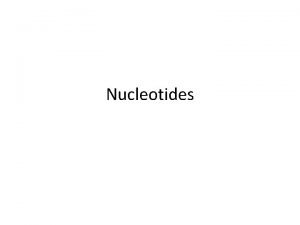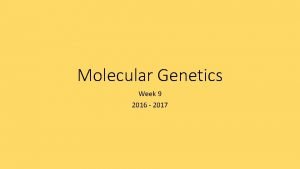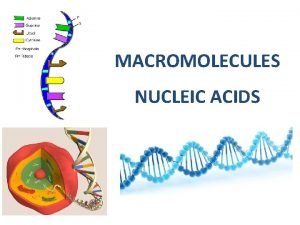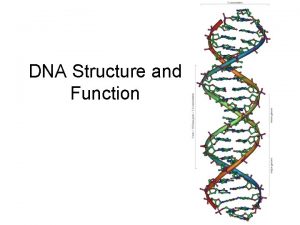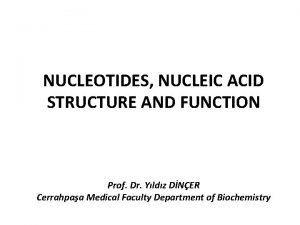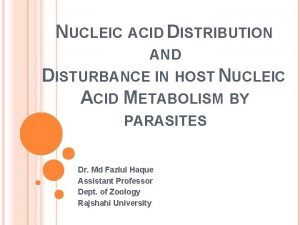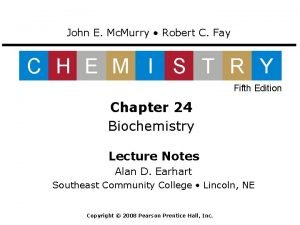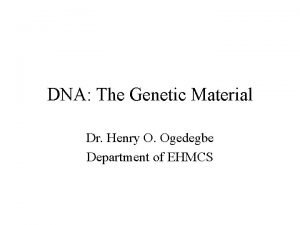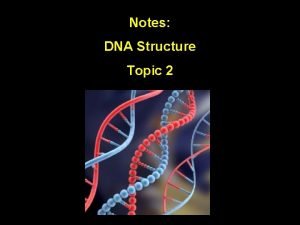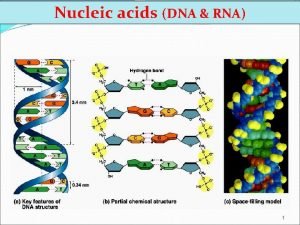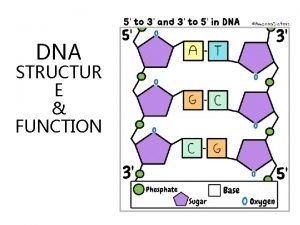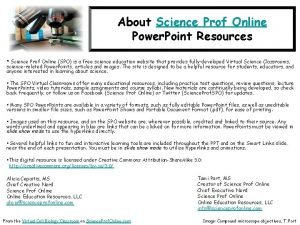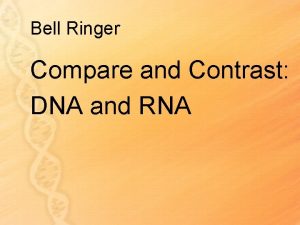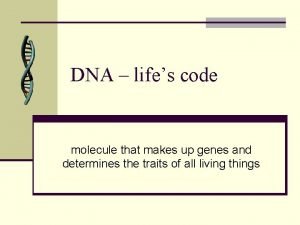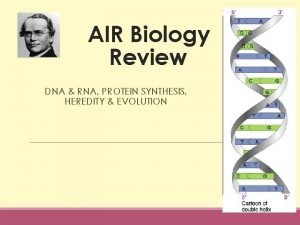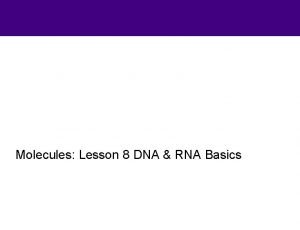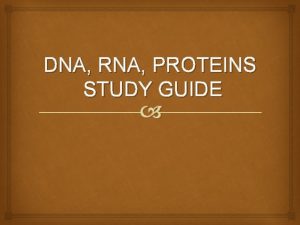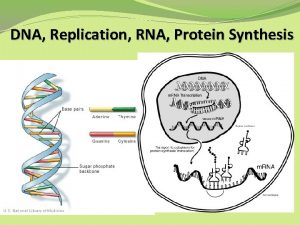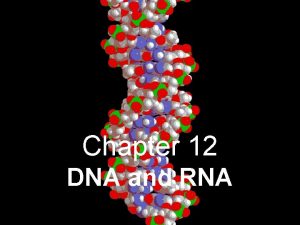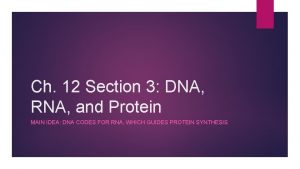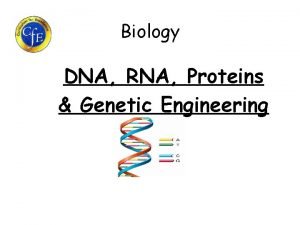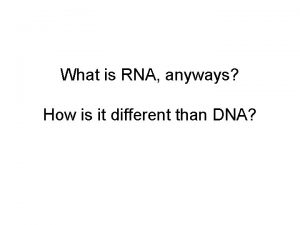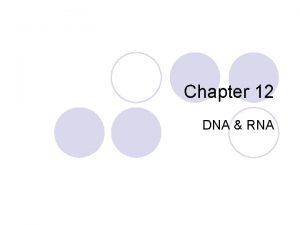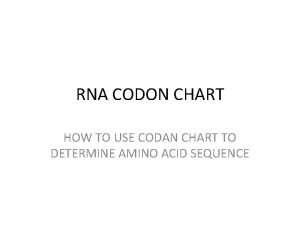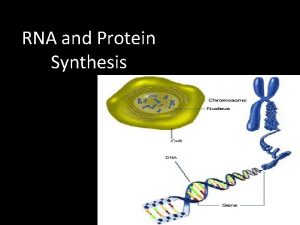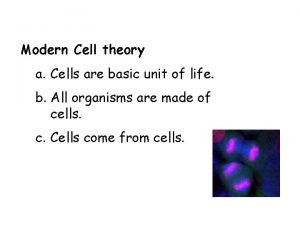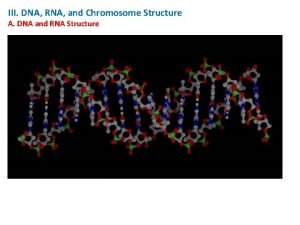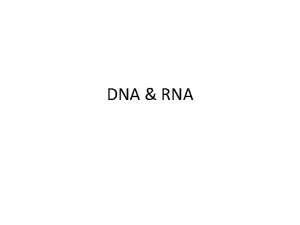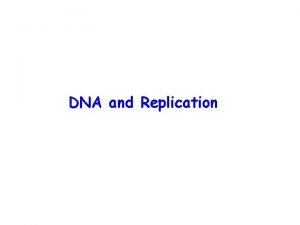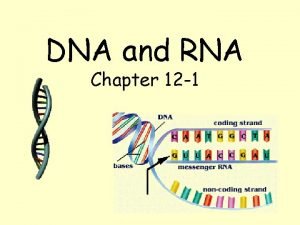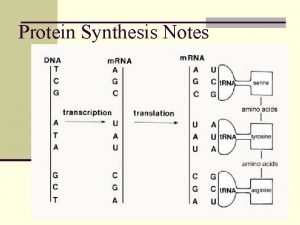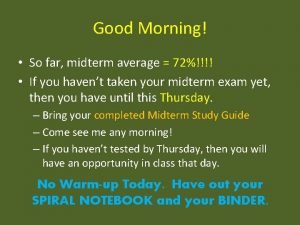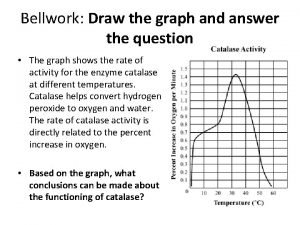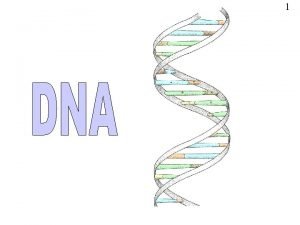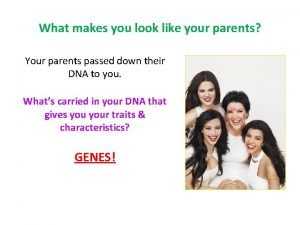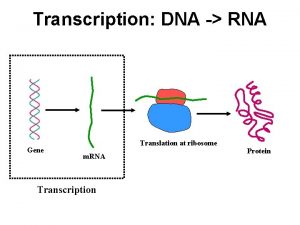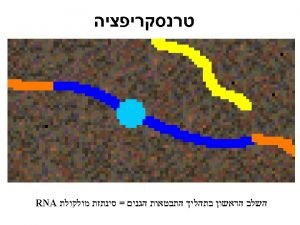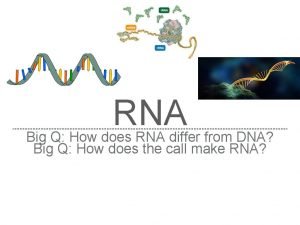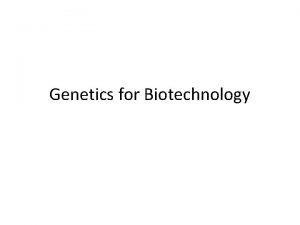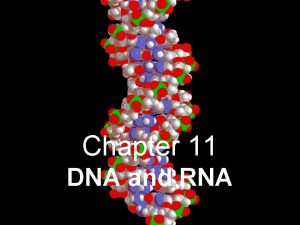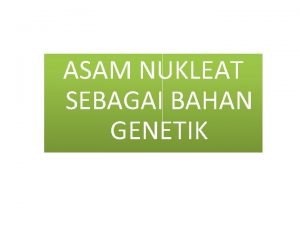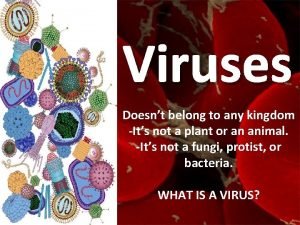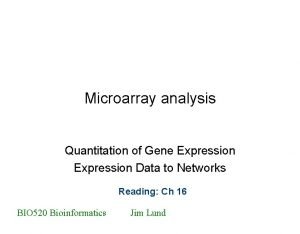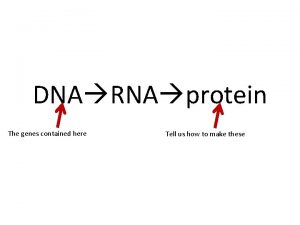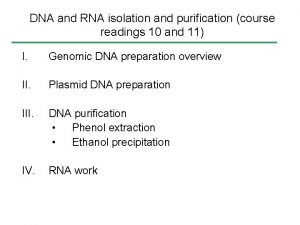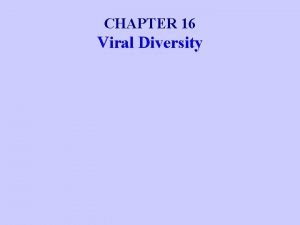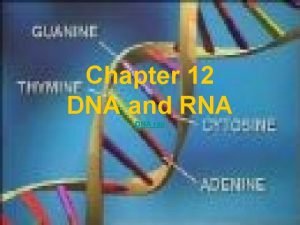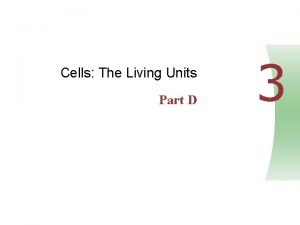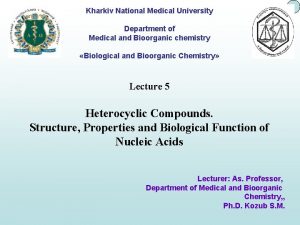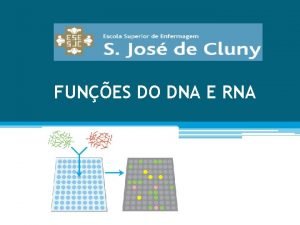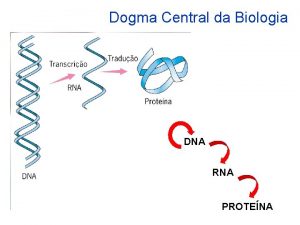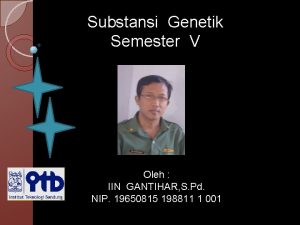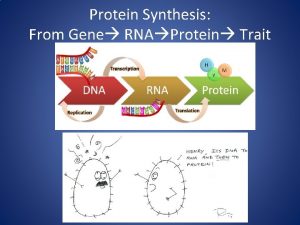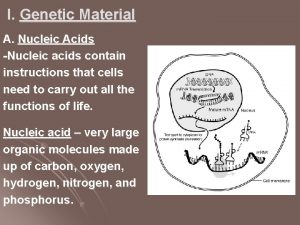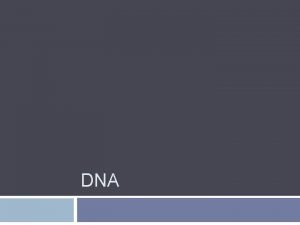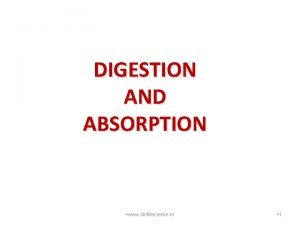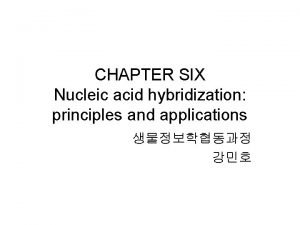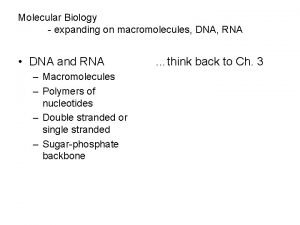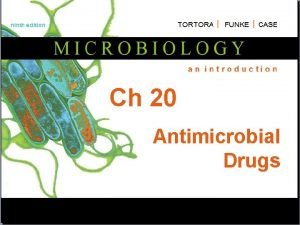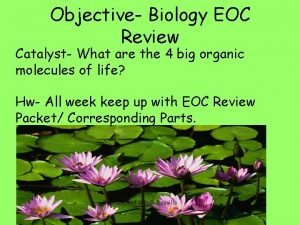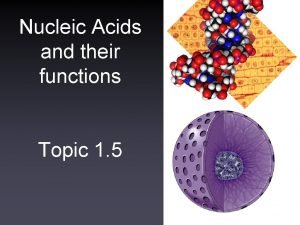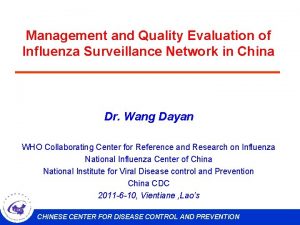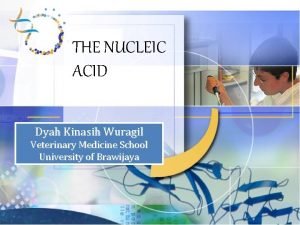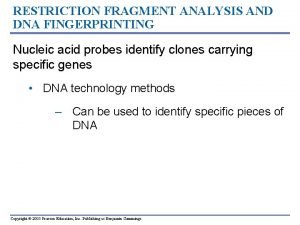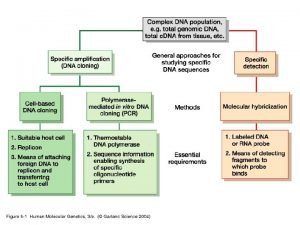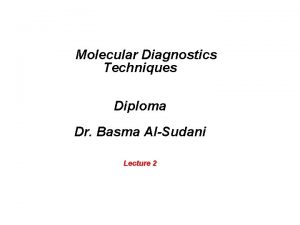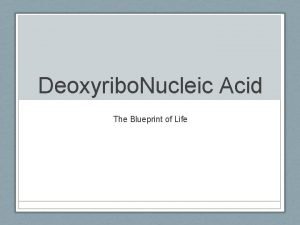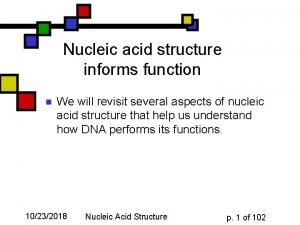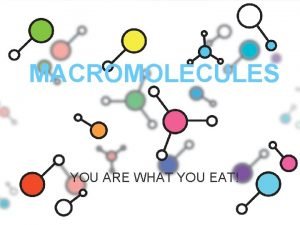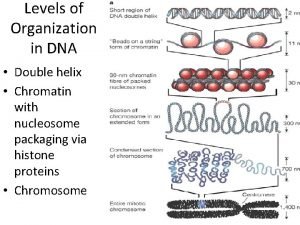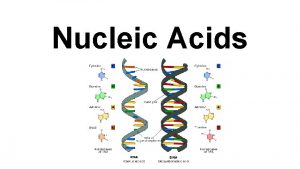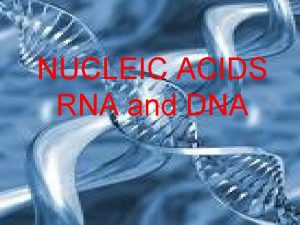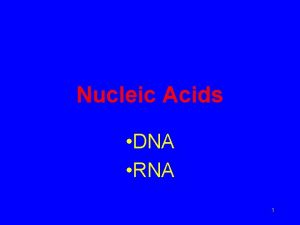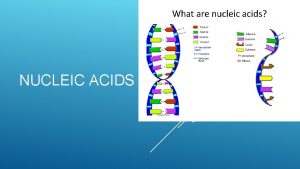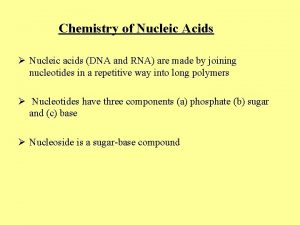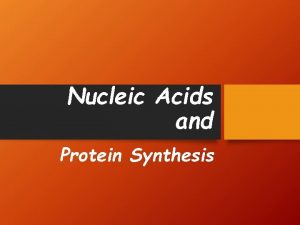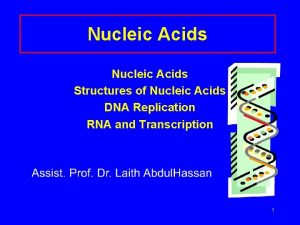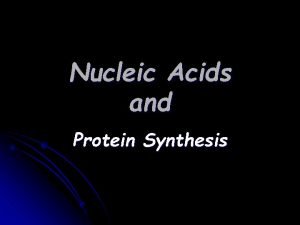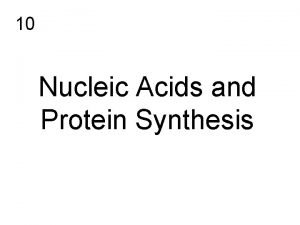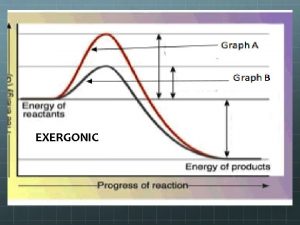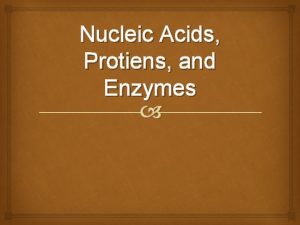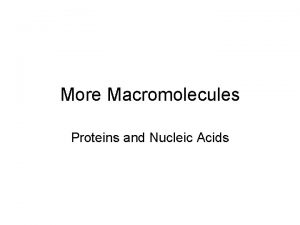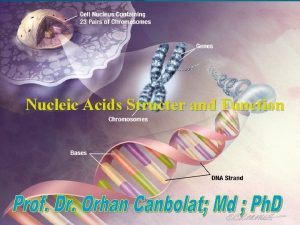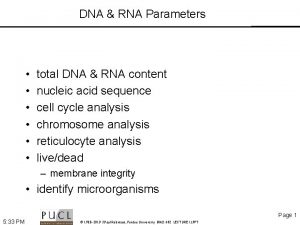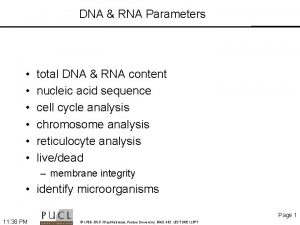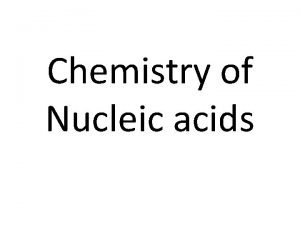DNA Nucleic Acids n DNA and RNA are























































































- Slides: 87

DNA

Nucleic Acids n DNA and RNA are examples – Deoxyribonucleic acid – Ribonucleic acid

Nucleic Acids n. A gene is a section of DNA that provides the code to make a protein.


Nucleic Acids n Built from monomers of nucleotides – Consists of a phosphate group, a sugar molecule, and a nitrogenous base

Nitrogenous bases n Purines – double ring -adenine, guanine n Pyrimidines – single ring – thymine, cytosine A=T C=G

Huge molecule over 3 billion base pairs per cell Condenses by wrapping/coiling around histones -called a chromosome DNA double helix (2 -nm diameter) Metaphase chromosome Tight helical fiber (30 -nm diameter) Linker “Beads on a string” Nucleosome (10 -nm diameter) Histones Supercoil (300 -nm diameter) 700 nm

How did we discover DNA is the genetic material? n In a group or individually, read through page 182 and figure 10. 1 B (183) n What did Fredrick Griffith discover? n What did Alfred Hershey and Martha Chase discover? What was their experiment?

Hershey Chase Animation

Phage Bacterium Radioactive protein Empty protein shell The radioactivity is in the liquid. Phage DNA Centrifuge Pellet Batch 1: Radioactive protein labeled in yellow Radioactive DNA Centrifuge Pellet Batch 2: Radioactive DNA labeled in green The radioactivity is in the pellet.

How was the double helix discovered? n Read pages 186 and 187


Thymine (T) Pyrimidines Cytosine (C) Adenine (A) Guanine (G) Purines

Recall: The experiment from Hershey and Chase (1952) demonstrated DNA is the passed from parents to offspring, but what is its structure? Phage Bacterium Radioactive protein DNA Empty protein shell The radioactivity is in the liquid. Phage DNA Centrifuge Pellet Batch 1: Radioactive protein labeled in yellow Radioactive DNA Centrifuge Pellet Batch 2: Radioactive DNA labeled in green The radioactivity is in the pellet.

Discovering the Structure of DNA n Watson and Crick were the first to discover the structure of DNA. – Used data x-ray crystallography data from Wilkins and Franklin without their permission

Earliest Model of DNA

Make our own models n Two simple steps – Label the nitrogenous bases – Fold it

DNA n We know the structure of DNA, and that more than 3 billion base pairs are in each cell, what about new cells?

DNA Replication n Depends pairs on specific base adenine – thymine guanine – cytosine If this is one half of DNA, what would the other half be?

DNA Replication n Semiconservative model – The two DNA strands separate (parent strands). – Each parent strand then becomes a template for a new, complementary strand (daughter strand) forming two new daughter molecules of DNA – Each new DNA helix has one old strand with one new strand.

Figure 10. 4 b A T G C A A Parental DNA molecule T A T C Daughter strand Parental strand G G C T T A G C C G G T T G C C A T A G A C C T A A T G A T T A C T Daughter DNA molecules

DNA Replication n Over a dozen enzymes and other proteins needed to replicate DNA n DNA polymerase – adds nucleotides one at a time to the strand – Other enzymes “proofread” and fix mistakes

DNA Replication n Replication same time occurs at multiple points at the


DNA Replication n The direction DNA polymerase moves is determined by the sugar phosphate backbone – There is a 5’ end a 3’ end – Nucleotides are added onto the 3’ end, moving towards the 5’ end Carbons are labeled


DNA polymerase molecule 5′ 3′ Parental DNA Replication fork 5′ 3′ DNA ligase Overall direction of replication 3′ This daughter 5′ strand is synthesized continuously This daughter strand is 3′ synthesized 5′ in pieces



Recall n. A gene is a section of DNA that provides the code to make a protein. n Genes carry different information on them n Human Genome mapped it out – ethical questions

n https: //www. youtube. com/watch? v=zwibg NGe 4 a. Y&feature=youtube_gdata_player

Parent molecule Daughter molecules

Parent strand Daughter strand

A T G C A A Parental DNA molecule T A T C Daughter strand G G C T T A Parental strand G C C G G T T G C C A T A G A C C T A A T G A T T A C T Daughter DNA molecules

Hypothetical DNA If this is the parent strand? What is the daughter strand? ATCCGTAA-

What was the main enzyme in DNA replication? What was unique as a result of the sugar phosphate backbone?

DNA polymerase molecule 5′ 3′ Parental DNA Replication fork 5′ 3′ DNA ligase Overall direction of replication 3′ This daughter 5′ strand is synthesized continuously This daughter strand is 3′ synthesized 5′ in pieces

https: //www. hhmi. org/biointeractive/dna-replication-basic-detail


n https: //www. hhmi. org/biointeractive/dna- replication-basic-detail

After DNA replicates, the cell divides Looking at that after break. Why is DNA Critical?

Transcription and Translation n DNA is transcribed into RNA n RNA is translated into protein DNA Transcription RNA NUCLEUS Translation Protein CYTOPLASM


DNA n Ingredientes: n 2 1 / 4 tazas de harina para todo uso 1 cucharadita de bicarbonato de soda 1 cucharadita de sal 1 taza (2 palos) de mantequilla, suavizada 3 / 4 taza de azúcar granulada 3 / 4 taza de azúcar morena 1 cucharadita de extracto de vainilla 2 huevos grandes 2 tazas (12 oz. Pkg. ) TELEPEAJE CASA NESTLÉ ® ® semi-dulce de chocolate bocados 1 taza de nueces picadas n n n n n

RNA n Ingredients: n To 2 1/4 cups all-purpose flour 1 teaspoon baking soda 1 teaspoon salt 1 cup (2 sticks) butter, softened 3/4 cup granulated sugar 3/4 cup brown sugar 1 teaspoon vanilla extract 2 large eggs 2 cups (12 oz. Pkg. ) NESTLÉ TOLL HOUSE ® ® semisweet chocolate morsels 1 cup chopped walnuts n n n n n

Protein

Transcription n Sections of DNA called genes are used n RNA polymerase attaches to the DNA at a ‘promoter’ site n It moves along the gene forming a new RNA strand using the base pair rules

Transcription n DNA Base pairs A-T G-C n RNA A-U G-C n There Base pairs is no thymine in RNA, a different nucleotide Uracil is used

DNA A C C G G C A A U U U G G C C G U U Transcription RNA Translation Codon Polypeptide Amino acid

Quick review

DNA replication n Lots of enzymes, DNA polymerase one of them

n DNA codes for protein n Only part of DNA is a gene

Transcription and Translation n DNA is transcribed into RNA n RNA is translated into protein DNA Transcription RNA NUCLEUS Translation Protein CYTOPLASM

DNA n Ingredientes: n 2 1 / 4 tazas de harina para todo uso 1 cucharadita de bicarbonato de soda 1 cucharadita de sal 1 taza (2 palos) de mantequilla, suavizada 3 / 4 taza de azúcar granulada 3 / 4 taza de azúcar morena 1 cucharadita de extracto de vainilla 2 huevos grandes 2 tazas (12 oz. Pkg. ) TELEPEAJE CASA NESTLÉ ® ® semi-dulce de chocolate bocados 1 taza de nueces picadas n n n n n

RNA n Ingredients: n To 2 1/4 cups all-purpose flour 1 teaspoon baking soda 1 teaspoon salt 1 cup (2 sticks) butter, softened 3/4 cup granulated sugar 3/4 cup brown sugar 1 teaspoon vanilla extract 2 large eggs 2 cups (12 oz. Pkg. ) NESTLÉ TOLL HOUSE ® ® semisweet chocolate morsels 1 cup chopped walnuts n n n n n

Protein

Transcription n Sections of DNA called genes are used n RNA polymerase attaches to the DNA at a ‘promoter’ site n It moves along the gene forming a new RNA strand using the base pair rules

Transcription n DNA Base pairs A-T G-C n RNA A-U G-C n There Base pairs is no thymine in RNA, a different nucleotide Uracil is used


Transcription RNA polymerase recognizes part of the DNA strand attaches at the promoter region

Transcription RNA synthesis begins after attachment

Transcription Using DNA as a template, RNA polymerase adds RNA nucleotides one at a time

Transcription Using DNA as a template, RNA polymerase adds RNA nucleotides one at a time If the DNA strand is: ATAGGC Then the RNA will be: UAUCCG UUACGCAUAGCG DNA - A A T G C G T A T C G C

Transcription RNA synthesis ends when RNA polymerase reaches the terminator DNA sequence

Direction of transcription Initiation RNA synthesis begins after RNA polymerase attaches to the promoter. Unused strand of DNA RNA polymerase Terminator DNA Newly formed RNA Promoter Elongation Template strand of DNA Direction of transcription DNA strands reunite Free RNA nucleotide U T Using the DNA as a template, RNA polymerase adds free RNA nucleotides one at a time. C DNA of gene AT C C A A TG AU GAU C C A A A T A GG T T A DNA strands separate Newly made RNA Termination RNA synthesis ends when RNA polymerase reaches the terminator DNA sequence. Terminator DNA Completed RNA polymerase detaches

Transcription and Translation n DNA is transcribed into RNA n RNA is translated into protein DNA Transcription RNA NUCLEUS Translation Protein CYTOPLASM Before leaving the nucleus, the RNA is processed

Exon DNA Exon Intron Cap RNA transcript with cap and tail Exon Intron Transcription Addition of cap and tail Introns removed Tail Exons spliced together m. RNA Coding sequence NUCLEUS CYTOPLASM

RNA processing n. A ‘cap’ and ‘tail’ are added – helps protect the RNA n Introns (intervening sequences) are removed n Exons (expressed sequences) are spliced together Exon DNA Exon Intron

Transcription and Translation n DNA is transcribed into RNA n RNA is translated into protein DNA Transcription RNA NUCLEUS Translation Protein CYTOPLASM

Translation n The genetic code is the amino acid translations of each of the nucleotide triplets. n Three nucleotides specify one amino acid

Translation Sixty-one codons correspond to amino acids n AUG codes for methionine and signals the start of translation n Three “stop” codons signal the end of translation n 64 Total

Strand to be transcribed DNA T A C T T C A A T C A T A G T T A G G A

Strand to be transcribed DNA T A C T T C A A T C A T G A A G T T A G A U G A A G U U A G Transcription RNA

Strand to be transcribed DNA T A C T T C A A T C A T G A A G T T A G A U G A A G U U A G Transcription RNA Translation Start codon Polypeptide Met Stop codon Lys Phe

Translation n Types of RNA – Messenger RNA – RNA that will be coded into protein (m. RNA) – Transfer RNA – RNA that is used in the decoding process (t. RNA) – Ribosomal RNA – part of the ribosome that puts the protein together (adds amino acids together) (r. RNA)

Translation n t. RNA – There are 61, for each of the codons – Contains a section called the anticodon that base pairs with the codon on m. RNA

Translation n Ribosome – A complex of r. RNA and protein – A small subunit and a large subunit – Contains two sites for t. RNA – A site and P site

Translation n How does it actually work? Recall, m. RNA was just transcribed in the nucleus and then processed before entering the cytoplasm DNA Transcription RNA NUCLEUS Translation Protein CYTOPLASM

Translation n m. RNA binds to a the small subunit of a ribosome n a t. RNA recognizes the start codon and binds

Translation n The large ribosomal subunit binds to the small subunit n The t. RNA fits into the P site

Translation n. A new t. RNA carrying an amino acid moves into the A site, amino acids are combined n The t. RNAs shift over n This repeats until stop codon is reached

Amino acid Polypeptide Anticodon A site P site m. RNA Codons 1 Codon recognition

Amino acid Anticodon A site Polypeptide P site m. RNA Codons 1 Codon recognition 2 Peptide bond formation

Amino acid Anticodon A site Polypeptide P site m. RNA Codons 1 Codon recognition New peptide bond 3 Translocation 2 Peptide bond formation

Amino acid Anticodon A site Polypeptide P site m. RNA Codons 1 Codon recognition m. RNA movement Stop codon New peptide bond 3 Translocation 2 Peptide bond formation

Try it n DNA: TACAATCGTACG n RNA: AUGUUAGCAUGC n Amino Acid: Met – Leu – Ala – Cys (one strand)

https: //www. youtube. com/watch? v=h 5 m. Jb. P 23 Buo
 Mikael ferm
Mikael ferm Dna and genes chapter 11
Dna and genes chapter 11 Building blocks of nucleic acids
Building blocks of nucleic acids Nucleic acids composition
Nucleic acids composition Nucleic acids concept map
Nucleic acids concept map The building block of nucleic acids.
The building block of nucleic acids. Polymer structure of nucleic acids
Polymer structure of nucleic acids Significance of nucleic acid
Significance of nucleic acid Cytosio
Cytosio Biologically important nucleotides
Biologically important nucleotides Properties of nucleotides
Properties of nucleotides Store and transmit genetic information
Store and transmit genetic information Nucleic acid
Nucleic acid Food that rich in nucleic acid
Food that rich in nucleic acid Nucleic acids
Nucleic acids Functions of nucleic acid
Functions of nucleic acid Nucleotide structure labeled
Nucleotide structure labeled Phosphodiester bonds
Phosphodiester bonds Chargaff's rule
Chargaff's rule Nucleic acid dna structure
Nucleic acid dna structure Compare and contrast dna and rna.
Compare and contrast dna and rna. Comparing dna and rna worksheet answers
Comparing dna and rna worksheet answers What is the goal of replication
What is the goal of replication Codon wheel
Codon wheel Dna double helix coloring worksheet answer key
Dna double helix coloring worksheet answer key Protein synthesis
Protein synthesis Dna and rna
Dna and rna Dna rna and proteins study guide answers
Dna rna and proteins study guide answers Difference between dna and rna extraction
Difference between dna and rna extraction Dna and rna
Dna and rna Chapter 12 dna and rna
Chapter 12 dna and rna Chapter 12 section 3 dna rna and protein
Chapter 12 section 3 dna rna and protein Dna protein synthesis study guide answers
Dna protein synthesis study guide answers Dna and rna
Dna and rna Dna and rna sugars
Dna and rna sugars Chapter 12 dna and rna
Chapter 12 dna and rna Amino acids table
Amino acids table Venn diagram of dna and rna
Venn diagram of dna and rna Cell theory
Cell theory Rna in chromosomes
Rna in chromosomes Dna and rna structure
Dna and rna structure Nitrogenous bases in dna and rna
Nitrogenous bases in dna and rna Chapter 12 dna the genetic material
Chapter 12 dna the genetic material Unlike dna, rna contains
Unlike dna, rna contains Cytoplasm structure
Cytoplasm structure Dna to rna rules
Dna to rna rules Dna number of strands
Dna number of strands Dna rna protein central dogma
Dna rna protein central dogma Ribosomem
Ribosomem Rna or dna
Rna or dna Big q
Big q Dna rna protein central dogma
Dna rna protein central dogma Virusmax
Virusmax Chargaff
Chargaff Ribosom
Ribosom What kingdom do viruses belong to
What kingdom do viruses belong to Dna rna protein
Dna rna protein Dna rna protein
Dna rna protein Dna rna protein diagram
Dna rna protein diagram Corona virus dna or rna
Corona virus dna or rna Dna rna
Dna rna Dna to rna transcription
Dna to rna transcription Somatic cells vs germ cells
Somatic cells vs germ cells James dewey watson
James dewey watson Proteinas histonas
Proteinas histonas Dna rna
Dna rna Substansi genetik dna dan rna mempunyai kesamaan yaitu
Substansi genetik dna dan rna mempunyai kesamaan yaitu Protein
Protein Coding dna and non coding dna
Coding dna and non coding dna Genetic material
Genetic material Dideoxyribonucleic
Dideoxyribonucleic Fructose
Fructose Colony hybridization
Colony hybridization Nucleic acid chart
Nucleic acid chart Inhibition of nucleic acid synthesis
Inhibition of nucleic acid synthesis Nucleic acid monomer
Nucleic acid monomer Nucleic
Nucleic Nucleic acid test
Nucleic acid test Infectious nucleic acid
Infectious nucleic acid Molecula
Molecula Nucleic acid
Nucleic acid Nucleic acid
Nucleic acid Types of nucleic acid
Types of nucleic acid Nucleic acid
Nucleic acid Nucleic acid
Nucleic acid Biological molecules you are what you eat
Biological molecules you are what you eat Different parts of chromosomes
Different parts of chromosomes Function of dna polymerase 3
Function of dna polymerase 3


